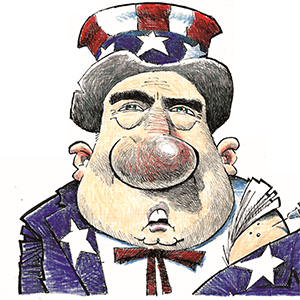California's dangerous heat wave is staying longer than expected, forecasters warn
Published in News & Features
LOS ANGELES — The oppressive heat wave broiling California and much of the West will continue to bring dangerously hot temperatures — and likely more record-breakers — for even longer than forecasters first predicted.
The heat advisories in effect across Southern California, including the extreme heat warning, are being extended through Sunday, said National Weather Service meteorologist Ryan Kittell. Most were set to expire Saturday.
Friday was still expected to bring peak temperatures, similar to conditions seen Thursday, “but the downward trend is very slow over the weekend,” Kittell said. “It’s still going to be very warm — well above normal — though the weekend. The evenings are going to be very warm as well.”
Many areas Thursday night into early Friday experienced little cooling, with temperatures across the L.A. Basin remaining near or above 70 degrees. Experts warn that lack of nighttime relief can be the most dangerous situation, as it doesn’t give the body a chance to recover from daytime highs — and can help fuel a wildfire, if one ignites.
“Extreme heat is dangerous even at night when temperatures don’t cool down,” the weather service’s Weather Prediction Center wrote in a heat wave update. “Without A/C or cooling, the body can’t recover, increasing the risk of heat illness.”
The city of Los Angeles has opened up additional cooling centers during the heat wave and the county has extended many of its hours for the air-conditioned sanctuaries.
But heat risk is not only a concern in Southern California. Even more severe temperatures are expected to continue for some areas of the desert Southwest, including Las Vegas and Phoenix, the Central Valley and parts of Northern California.
The Weather Prediction Center forecast “the most intense and long-lasting heat across the Desert Southwest into the San Joaquin Valley,” but said heat advisories remain in place from Arizona to Washington.
“This type of heat will be dangerous, posing a threat to anyone without effective cooling and adequate hydration,” the center’s short-range forecast said. “For many areas, there will be little nighttime relief from the extreme heat, with overnight lows remaining well above normal.”
The interior Bay Area remains under a heat advisory through Saturday, where highs already broke several daily records Thursday and could continue to reach near or into the triple digits.
Officials continue to warn the heat wave would bring an elevated fire threat across the region — a concern that was realized Thursday afternoon in Napa County, where a major fire broke out. The building heat helped fuel quick growth with massive smoke plumes, forcing evacuations. As of Friday, the Pickett fire had grown to 2,133 acres with no containment, according to the California Department of Forestry and Fire Protection.
“Heat also means fire danger,” Cal Fire reiterated in a social media post. Two other smaller fires broke out in the state Thursday, though officials appeared to have those under control.
The National Weather Service, however, continued to warn that parts of Southern California remained under the biggest threat for explosive fire growth, with the L.A. and Ventura County mountains and foothills under a red flag warning through Saturday.
Southern California Edison said Friday it was considering planned electricity shutoffs to minimize wildfire risk for about 10,000 customers across six counties, with the majority in L.A. County. No power shutoffs had yet been initiated, the utility reported.
Many of those same areas under elevated fire threat have the highest chance for monsoonal thunderstorms, which forecasters said could create hazards through at least Monday.
The storms, most likely in the mountains and deserts, could bring localized winds, flooding, debris flows and the chance for dry lightning, which could spark more fires.
While most heat advisories will expire by Sunday, Kittell said temperatures will remain elevated. Highs are forecast to fall a degree or two each day through Monday, getting thermometers back to average for this time of year by midweek — though they won’t be anywhere near cool.
“It’s the warmest time of year,” Kittell said. “By the time we get into Tuesday, Wednesday we’ll start to get back to around normal — which is still warm.”
These are a few of the daily high temperature records around Southern California that were tied or broken on Thursday, according to the National Weather Service:
—Camarillo Airport: 89 degrees (tied with prior record)
—Campo: 106 degrees (prior record was 103)
—Lake Cuyamaca: 96 degrees (prior record was 94)
—Palomar Mountain: 93 degrees (tied with prior record)
—Needles: 117 degrees (tied the prior record)
Records tied or set in Northern California for Thursday:
—Sonoma County Airport: 100 degrees (prior record 97)
—San Rafael: 100 degrees (previous record 97)
—Concord Airport: 101 degrees (previous record 99)
—Oakland Museum: 85 degrees (previous record 84)
Livermore Airport: 102 degrees (previous record 101)
—Redwood City: 97 (previous record 95)
›Hayward Airport: 85 degrees (previous record 83)
—Wastonville Airport: 85 (pevious record 83)
Las Vegas set a record for its warmest low temperature Thursday, never dropping below 89 degrees. Its previous record for the day was 87 degrees, according to the National Weather Service.
©2025 Los Angeles Times. Visit at latimes.com. Distributed by Tribune Content Agency, LLC.







Comments